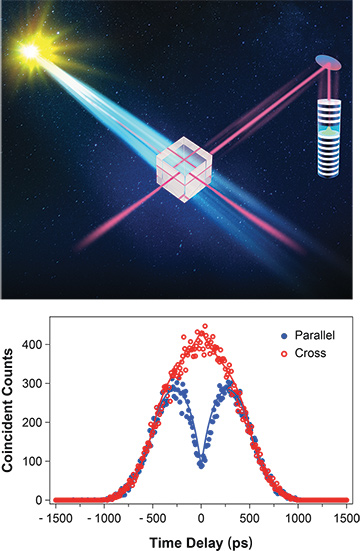 Top: Artist’s interpretation of setup for two-photon interference between photons from a quantum dot (QD) and sunlight. The InAs/GaAs QD was embedded in a 2-µm micropillar and sandwiched between 25.5 (15) λ/4-thick AlAs/GaAs mirror pairs, forming lower and upper distributed Bragg reflectors. Bottom: Two-photon coincidence counts at orthogonal (red) and parallel (blue) polarizations. [Enlarge figure]
Top: Artist’s interpretation of setup for two-photon interference between photons from a quantum dot (QD) and sunlight. The InAs/GaAs QD was embedded in a 2-µm micropillar and sandwiched between 25.5 (15) λ/4-thick AlAs/GaAs mirror pairs, forming lower and upper distributed Bragg reflectors. Bottom: Two-photon coincidence counts at orthogonal (red) and parallel (blue) polarizations. [Enlarge figure]
Can any two photons in the universe—no matter how distantly separated and independent are the sources they originate from—show quantum interference and entanglement? According to quantum theory, when two indistinguishable single photons impinge upon a 50:50 beam splitter, they bunch together out of the same output port.1 The classical picture of electromagnetic fields fails to explain the interference of two photons from independent sources with a visibility higher than 50%.2
This year, we undertook an experiment to test quantum interference between two astronomically separated light sources: a semiconductor quantum dot (QD) and the sun.3 The QD is coupled to a microcavity, which yields a high photon extraction efficiency of 0.82. Under pulsed resonant excitation, the QD source emits 2.56×107 photons per second, with a single-photon purity of 0.989 ± 0.001 and an indistinguishability of 0.952 ± 0.003.4
Photons from sunlight differ dramatically from the QD single photons in polarization, spatial modes, spectral and temporal properties, and photon statistics. To observe quantum interference, the two photon sources needed to be engineered to be quantum mechanically indistinguishable. To do so, we applied spectral filtering with a bandwidth of 1 GHz to match the spectrum of the sunlight to that of the QD single photons. Fast single-photon detection, with time resolution of around 20 ps, was used to discriminate and post-select the photons that overlapped on the beam splitter simultaneously. The relative intensity of the two sources was optimized to suppress unwanted multiphoton events from the sunlight.3
The result was time-resolved two-photon interference with a raw visibility of 0.796 ± 0.017, well above the classical limit of 0.5—thereby conclusively establishing the quantum nature5 of the two-photon interference between the QD photons and the solar ones. The thermal light from the sun, which usually requires only classical optics for its description, has now been involved in a highly non-classical, quantum-optics experiment.
Further, even though the two astronomically separated photons clearly have no common history, we demonstrated post-selected two-photon entanglement with a fidelity of 0.826(24), and a violation of Bell’s inequality by 3.3 standard deviations. The work can be further extended to a larger scale using photons from distant stars—opening a new route to quantum-optics experiments at an astronomical scale.
Researchers
Y.H. Deng, H. Wang, X. Ding, C.-Y. Lu and J.-W. Pan, University of Science and Technology of China, Hefei, China
J.P. Dowling, Louisiana State University, Baton Rouge, La., USA
S. Höfling, University of Würzburg, Würzburg, Germany
M. Scully, Texas A&M University, College Station, Texas, USA
References
1. H. Paul. Rev. Mod. Phys. 58, 209 (1986).
2. C.K. Hong et al. Phys. Rev. Lett. 59, 2044 (1987).
3. Y.H. Deng et al. Phys. Rev. Lett. 123,080401 (2019).
4. X. Ding et al. Phys. Rev. Lett. 116, 020401 (2016).
5. D.F. Walls. Nature 280, 451 (1979).

